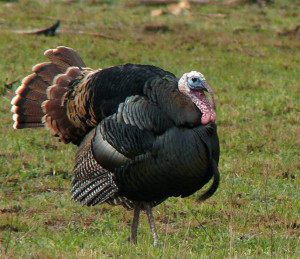
The Wild Turkey (Meleagris gallopavo) comes to mind around Thanksgiving time. In the last 10-15 years this species usually shows up on our Christmas Bird Count (CBC), most frequently in the northeastern part of the CBC circle; on rare occasions years ago, I would hear reports of turkeys and their tracks being seen infrequently in Stinchcomb Wildlife Preserve. For quite a number of years Ernie Wilson and Dave Evans used to see them on our CBC in northeastern Oklahoma City. As I understood it Ernie and Dave would go to a certain estate in that part of town, sit down with the home owner who would pour them a cup of coffee and wait for the birds to show up in the owner’s yard, which they always did—simple as that.
A number of years ago, before Ernie and Dave started seeing them in northeastern Oklahoma City, I nearly put down this species on my CBC list, but ultimately had to pass on it. I was working near the northwest end of the Stinchcomb Wildlife Refuge, northwest of Lake Overholser. It was getting late in the evening and I saw a big bird high in a tree and some distance from me. I started easing my way toward it and as I was approaching I felt pretty sure that it was a turkey. I kept moving very slowly toward the bird, expecting it to fly at any moment, because Wild Turkeys usually are very wary. But for some reason this bird did not fly. Finally I was almost under the tree. I think I even shouted at it and clapped my hands, but it did not fly. It was then I noticed that the bird had some “tame” features about it, features I cannot now recall exactly, but definitely there—I think maybe it looked like a cross between a white turkey and a regular plumaged turkey. Putting everything together, the lack of wariness and certain features on the bird, I realized that this might be a half-breed tame/wild turkey. Then I realized that if I had just identified the bird from a distance, I could have added another species to the CBC list, but no, I had to be too nosy! It did occur to me afterwards that I might try to claim ½ of a species on our CBC list, for the wild part of the turkey! But I knew that would never have made it past the CBC experts who would review the list later—I just wanted to do it for the fun of tweaking some editors. And also I could not be sure that the “wild” half of the turkey might actually be from a normal colored domestic turkey. Anyway, I was glad I stayed with the bird until the mystery was solved.
The number of domesticated turkeys produced each year in the U.S. is roughly 260 million birds; by comparison the number of Wild Turkeys found in the U.S. is estimated at over 7 million birds. Wild Turkeys are found in every state except Alaska and it is a game bird in all the states where it is found. (The source for this statement did not exclude Hawaii, so I assume they are found, and hunted, there as well.) It nests on the ground and lays from 8 to 16 eggs. Usually adult Wild Turkeys are very wary; but if an intruder gets too close to a female’s young, that female will be extremely brave in using distraction displays trying to lead the intruder away from the young.
The history of domestication of the Wild Turkey is interesting. Evidence points to their domestication at least 2000 years ago in central Mexico; they have been highly prized for their tasty meat. Some domesticated turkeys in North America were then transported to Europe in 1519 by the Spanish, where they were also kept as domestic birds. Then some of these domesticated European birds were transported back to North America, two examples being to Jamestown, Virginia, in 1608 and on the Mayflower with the Pilgrams in 1620. Such birds were then allowed to breed with Wild Turkeys in North America, which helped increase the overall turkey population. With so much back and forth breeding between wild and tame birds, counting a “partially tame” bird “back when” does not sound so much like a farfetched idea!
